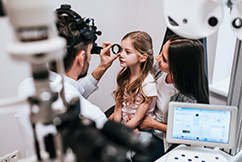
If your child was just diagnosed with nearsightedness (myopia), you might be feeling overwhelmed. Maybe you’ve noticed them squinting at the board, holding books too close, or struggling with frequent prescription changes. Myopia can sneak up fast, but the good news is, we’ll help you understand what’s happening and what to do next.
At Professional Family Eyecare, we help families take control of childhood myopia with safe, proven treatments designed to slow its progression. That means clearer vision now and a lower risk of more serious eye problems later.
What Is Myopia?
Myopia, or nearsightedness, happens when the eyeball grows too long from front to back. This makes it harder to see things clearly at a distance. It’s a common condition that usually begins in childhood and tends to worsen as kids grow. Left untreated, high myopia can raise the risk of eye diseases like glaucoma or retinal detachment later in life.
That’s why managing myopia early can make such a big difference.
What Are Myopia Treatment Options?
There’s no one-size-fits-all plan and we don’t expect parents to have it all figured out. Our team will walk you through each step.
At Professional Family Eyecare, we offer several options that are safe, effective, and designed just for kids. Our doctors will help you find the approach that fits your child’s age, vision needs, and daily routine.
Here’s what we may recommend:
MiSight® Contact Lenses
These soft daily lenses are FDA-approved to slow the progression of myopia in children. They’re for kids, easy to use, and worn during the day, no overnight wear needed.
Low-Dose Atropine Drops
Atropine drops for myopia in kids are used before bed to help slow eye growth. They’re easy to use, well-tolerated, and have minimal side effects.
Myopia Control Glasses
Special lens technology helps reduce eye strain and manage how light enters the eye. These are a great option for younger kids or those not ready for contacts.
Healthy Lifestyle Changes
We’ll talk through screen habits, outdoor play, and other ways to support eye health at home. Even small changes can have a big impact.
Your Child’s First Myopia Visit: What to Expect
Our myopia evaluations go beyond a standard eye exam. We take time to get to know your child, learn about their routine, and explain everything in plain language.
During the visit, we may:
- Measure the shape and length of the eye
- Ask about vision changes or symptoms at school or home
- Look at daily routines like screen time and reading
- Walk through treatment options that match your child’s comfort level and lifestyle
We’ll answer all your questions, and we never rush decisions. We aim to support your family and help them feel confident every step of the way.
Why Early Myopia Treatment Matters
Myopia in kids doesn’t go away on its own, and it often gets worse as children grow. The earlier we begin treatment, the more we can do to slow it down and reduce future risks.
Even small changes in vision can affect how a child learns, plays, and feels about themselves. That’s why we recommend regular check-ins, typically every 6 to 12 months, to stay ahead of any shifts.
Why Families Trust Our Myopia Program
At Professional Family Eyecare, we treat your kids like we’d treat our own. Our team includes pediatric-trained doctors who understand how to make visits simple, low-stress, and even fun.
Whether your child is brand new to glasses or already struggling with frequent prescription changes, we’re here to help them see clearly today and stay ahead of future vision issues.
With four family-focused locations in Ohio, we make it easy to get personalized care close to home. We’ll tailor every visit to your child’s age, needs, and comfort, and we’re always here to answer questions.
Ready to get started? Book your child’s myopia consultation today and let us help you protect their long-term vision.
FAQ: Common Questions About Childhood Myopia
How often does my child need to come in?
Most kids in our program visit every 6 to 12 months so we can track progress and adjust as needed.
Are the treatments painful or hard to use?
Not at all. Options like MiSight® lenses and atropine drops are kid-friendly and easy to use. We walk you through everything.
Can my child still play sports or swim with these treatments?
Yes. We’ll help you pick an option that works with their lifestyle so they can stay active without worry.
Is myopia dangerous?
Mild myopia isn’t dangerous on its own, but if it progresses too far, it can increase the risk of serious eye conditions later. That’s why early care is so important.
When will we see results?
Most families notice improvements in prescription stability within the first year. The goal is to slow progression—not reverse it—and over time, that makes a real difference.
